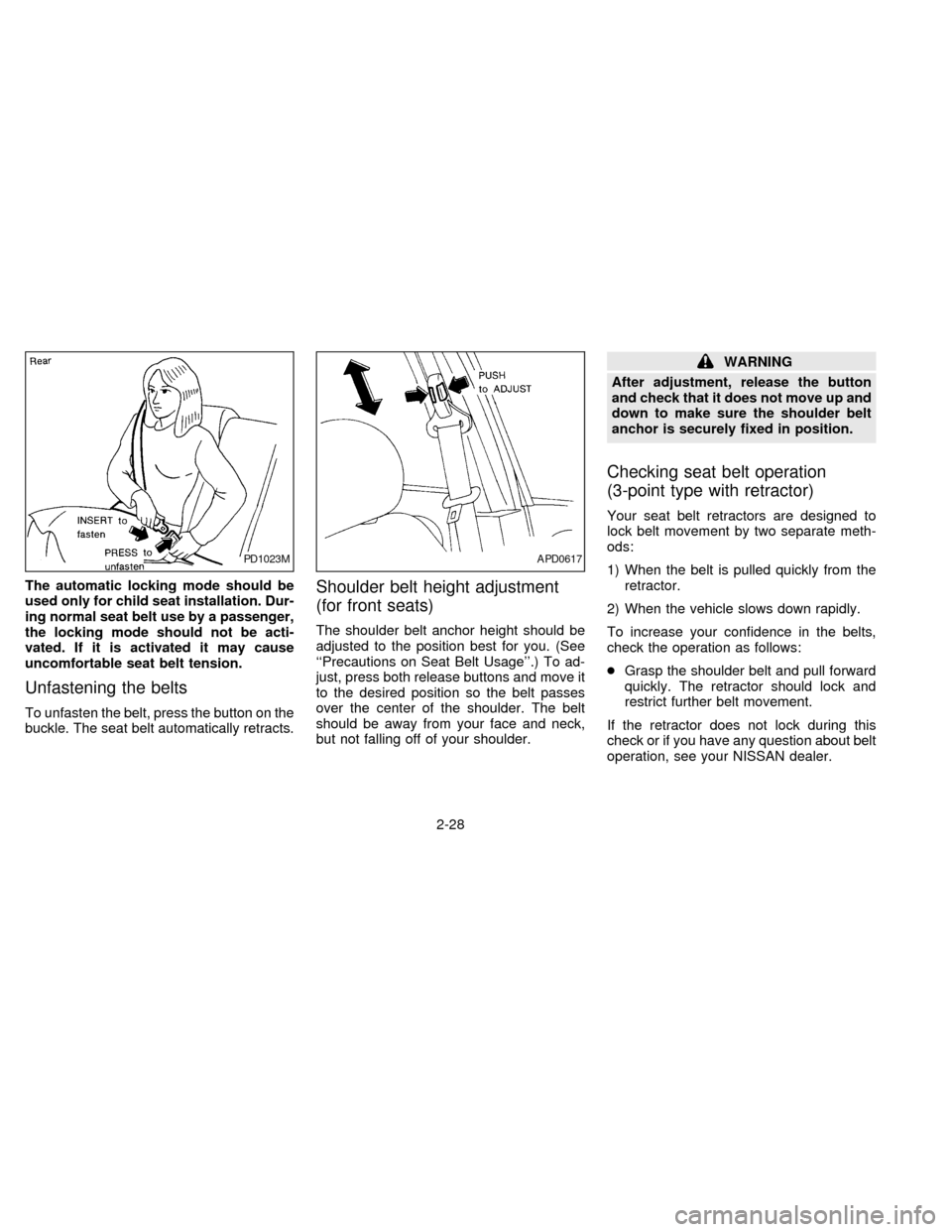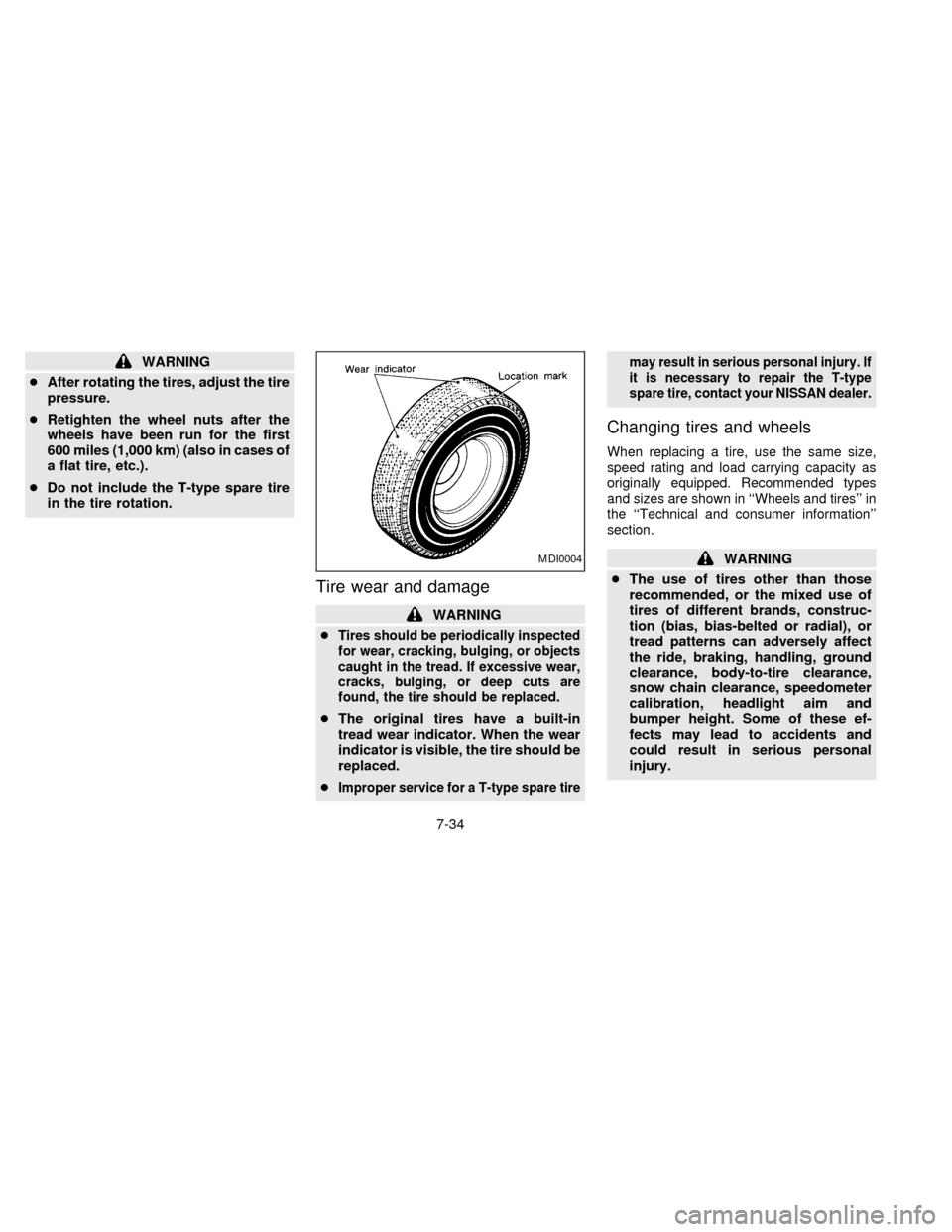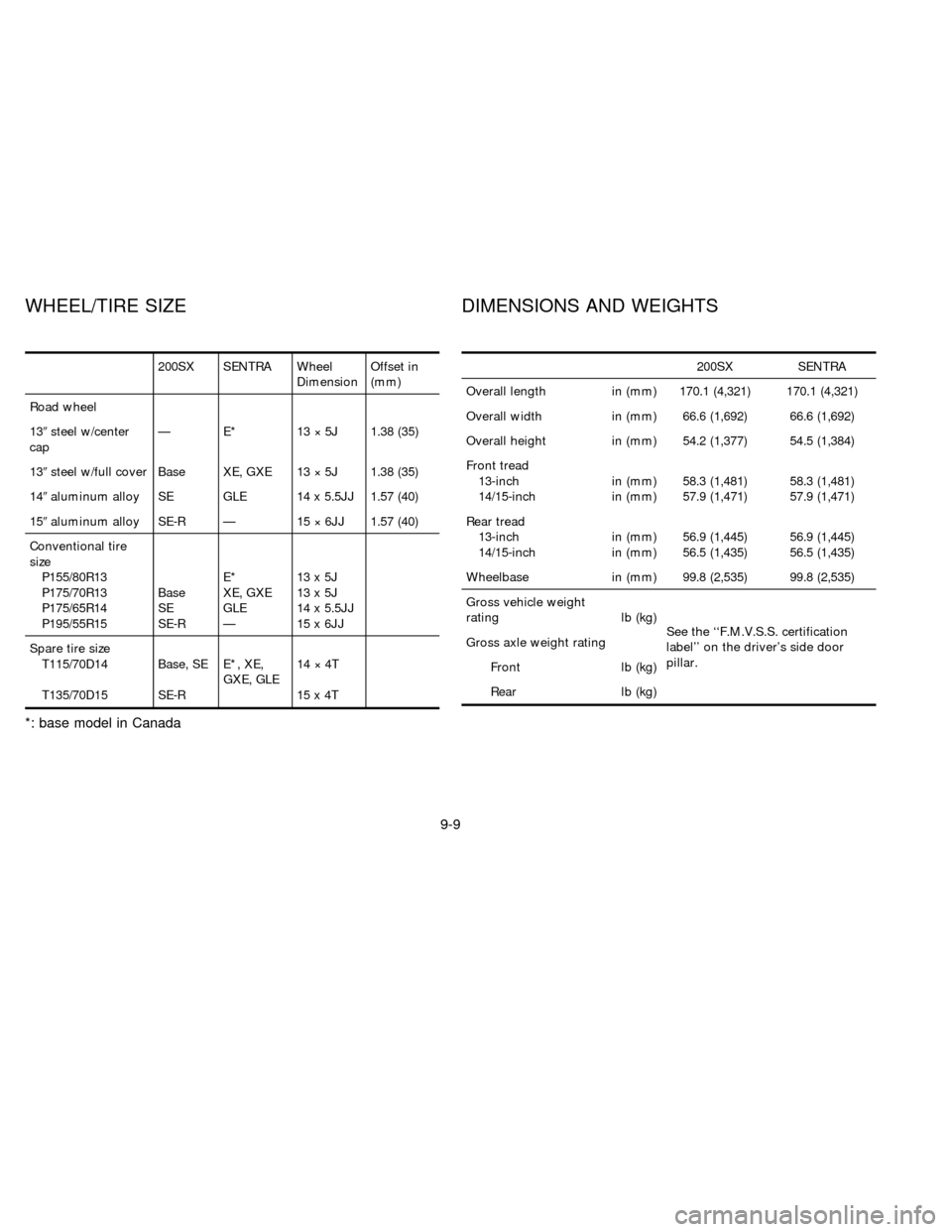1997 NISSAN SENTRA height
[x] Cancel search: heightPage 56 of 194

The automatic locking mode should be
used only for child seat installation. Dur-
ing normal seat belt use by a passenger,
the locking mode should not be acti-
vated. If it is activated it may cause
uncomfortable seat belt tension.
Unfastening the belts
To unfasten the belt, press the button on the
buckle. The seat belt automatically retracts.
Shoulder belt height adjustment
(for front seats)
The shoulder belt anchor height should be
adjusted to the position best for you. (See
``Precautions on Seat Belt Usage''.) To ad-
just, press both release buttons and move it
to the desired position so the belt passes
over the center of the shoulder. The belt
should be away from your face and neck,
but not falling off of your shoulder.
WARNING
After adjustment, release the button
and check that it does not move up and
down to make sure the shoulder belt
anchor is securely fixed in position.
Checking seat belt operation
(3-point type with retractor)
Your seat belt retractors are designed to
lock belt movement by two separate meth-
ods:
1) When the belt is pulled quickly from the
retractor.
2) When the vehicle slows down rapidly.
To increase your confidence in the belts,
check the operation as follows:
cGrasp the shoulder belt and pull forward
quickly. The retractor should lock and
restrict further belt movement.
If the retractor does not lock during this
check or if you have any question about belt
operation, see your NISSAN dealer.
PD1023MAPD0617
2-28
ZX
Page 144 of 194

normal, it may be due to a lack of adjust-
ment of the rear drum brakes. Apply the
parking brake several times.
WARNING
See your NISSAN dealer and have it
checked if the brake pedal height does
not return to normal.
Brake pad wear indicators
The disc brake pads on your vehicle have
audible wear indicators. When a brake pad
requires replacement, it makes a high
pitched scraping or screeching sound when
the vehicle is in motion whether or not the
brake pedal is depressed. Have the brakes
checked as soon as possible if the wear
indicator sound is heard.
Under some driving or climate conditions,
occasional brake squeak, squeal or other
noise may be heard. Occasional brake
noise during light to moderate stops is nor-
mal and does not affect the function or
performance of the brake system.
The rear drum brakes (if so equipped) do
not have audible wear indicators. Should
you ever hear an unusually loud noise fromthe rear drum brakes, have them inspected
as soon as possible by your NISSAN
dealer.
Proper brake inspection intervals should
be followed.For more information regard-
ing brake inspections, see the appropriate
maintenance schedule information in the
``Maintenance Schedule'' section of this
manual.Check the brake booster function as fol-
lows:
1. With the engine off, press and release
the brake pedal several times. When
brake pedal movement (distance of
travel) remains the same from one pedal
application to the next, continue on to the
next step.
2. While depressing the brake pedal, start
the engine. The pedal height should drop
a little.
3. With the brake pedal depressed, stop the
engine. Keeping the pedal depressed for
about 30 seconds, the pedal height
should not change.
4. Run the engine for one minute without
depressing the brake pedal, then turn it
off. Depress the brake pedal several
times. The pedal travel distance will de-
crease gradually with each depression
as the vacuum is released from the
booster.
If the brakes do not operate properly, see
your NISSAN dealer.
BRAKE BOOSTER
7-22
ZX
Page 156 of 194

WARNING
cAfter rotating the tires, adjust the tire
pressure.
cRetighten the wheel nuts after the
wheels have been run for the first
600 miles (1,000 km) (also in cases of
a flat tire, etc.).
cDo not include the T-type spare tire
in the tire rotation.
Tire wear and damage
WARNING
c
Tires should be periodically inspected
for wear, cracking, bulging, or objects
caught in the tread. If excessive wear,
cracks, bulging, or deep cuts are
found, the tire should be replaced.
cThe original tires have a built-in
tread wear indicator. When the wear
indicator is visible, the tire should be
replaced.
c
Improper service for a T-type spare tiremay result in serious personal injury. If
it is necessary to repair the T-type
spare tire, contact your NISSAN dealer.
Changing tires and wheels
When replacing a tire, use the same size,
speed rating and load carrying capacity as
originally equipped. Recommended types
and sizes are shown in ``Wheels and tires'' in
the ``Technical and consumer information''
section.
WARNING
cThe use of tires other than those
recommended, or the mixed use of
tires of different brands, construc-
tion (bias, bias-belted or radial), or
tread patterns can adversely affect
the ride, braking, handling, ground
clearance, body-to-tire clearance,
snow chain clearance, speedometer
calibration, headlight aim and
bumper height. Some of these ef-
fects may lead to accidents and
could result in serious personal
injury.MDI0004
7-34
ZX
Page 177 of 194

200SX SENTRA Wheel
DimensionOffset in
(mm)
Road wheel
139steel w/center
capÐ E* 13 ý 5J 1.38 (35)
139steel w/full cover Base XE, GXE 13 ý 5J 1.38 (35)
149aluminum alloy SE GLE 14 x 5.5JJ 1.57 (40)
159aluminum alloy SE-R Ð 15 ý 6JJ 1.57 (40)
Conventional tire
size
P155/80R13 E* 13 x 5J
P175/70R13 Base XE, GXE 13 x 5J
P175/65R14 SE GLE 14 x 5.5JJ
P195/55R15 SE-R Ð 15 x 6JJ
Spare tire size
T115/70D14 Base, SE E*, XE,
GXE, GLE14ý4T
T135/70D15 SE-R 15 x 4T
*: base model in Canada
200SX SENTRA
Overall length in (mm) 170.1 (4,321) 170.1 (4,321)
Overall width in (mm) 66.6 (1,692) 66.6 (1,692)
Overall height in (mm) 54.2 (1,377) 54.5 (1,384)
Front tread
13-inch in (mm) 58.3 (1,481) 58.3 (1,481)
14/15-inch in (mm) 57.9 (1,471) 57.9 (1,471)
Rear tread
13-inch in (mm) 56.9 (1,445) 56.9 (1,445)
14/15-inch in (mm) 56.5 (1,435) 56.5 (1,435)
Wheelbase in (mm) 99.8 (2,535) 99.8 (2,535)
Gross vehicle weight
rating lb (kg)
See the ``F.M.V.S.S. certification
label'' on the driver's side door
pillar. Gross axle weight rating
Front lb (kg)
Rear lb (kg)
WHEEL/TIRE SIZE DIMENSIONS AND WEIGHTS
9-9
ZX
Page 192 of 194

Engine oil and oil filter
recommendation ..................................... 9-5
Engine oil viscosity ................................. 9-5
Opener lever for trunk lid............................. 2-8
Outside mirror control ................................ 2-38
Overdrive switch .......................................... 4-8
Overheat
If your vehicle overheats ...................... 5-10
Owner's manual order form ....................... 9-20
P
Parking
Parking brake check ............................. 7-21
Parking brake operation ....................... 4-11
Parking/parking on hills ........................ 4-15
Periodic maintenance schedules ................. 8-5
Power
Power door lock...................................... 2-3
Power steering fluid .............................. 7-13
Power windows..................................... 1-16
Rear power windows ............................ 1-17
Precautions
Maintenance precautions ....................... 7-2
Precautions on seat belt usage............ 2-24
Precautions when starting and
driving ..................................................... 4-2
Push starting ................................................ 5-9R
Radio
AM-FM radio with cassette player ....... 3-11,
3-13
CB radio or car phone .......................... 3-15
Readiness for inspection maintenance (I/M)
test ............................................................. 9-19
Rear power windows ................................. 1-17
Rear seat ................................................... 2-15
Rear window defogger switch ................... 1-11
Refrigerant recommendation ....................... 9-7
Registering your vehicle in another
country ....................................................... 9-10
Remote keyless entry system (See
multi-remote control system) ....................... 2-3
Reporting safety defects (USA) ................. 9-18
S
Safety
Child safety rear door lock ..................... 2-6
Reporting safety defects (USA) ............ 9-18
Seat adjustment ......................................... 2-12
Seat belt
2-point type without retractor (rear center
lap belt) ................................................. 2-29
3-point type with retractor..................... 2-27
Precautions on seat belt usage............ 2-24
Seat belt extenders .............................. 2-30
Seat belt maintenance.......................... 2-30
Seat belts.............................................. 2-24Shoulder belt height adjustment ........... 2-28
Seat belt warning light ................................. 1-6
Seats
Front seats............................................ 2-12
Rear seat .............................................. 2-15
Service manual order form ........................ 9-20
Servicing air conditioner .............................. 3-9
Shifting
Automatic transmission .......................... 4-7
Manual transmission............................... 4-9
Shoulder belt height adjustment ................ 2-28
Spark plug replacement............................. 7-18
Speedometer ............................................... 1-3
SRS warning label ..................................... 2-22
Starting
Before starting the engine ...................... 4-5
Jump starting .......................................... 5-7
Precautions when starting and
driving ..................................................... 4-2
Push starting........................................... 5-9
Starting the engine ............................... 4-11
Steering
Power steering fluid .............................. 7-13
Tilting steering wheel............................ 2-37
Stop light .................................................... 7-26
Sunroof ...................................................... 1-18
Supplemental restraint system (Supplemental
air bag system) .......................................... 2-16
Switch
Automatic power window switch .......... 1-17
Front fog light switch ............................ 1-13
Hazard warning flasher switch ............. 1-14
10-4
ZX